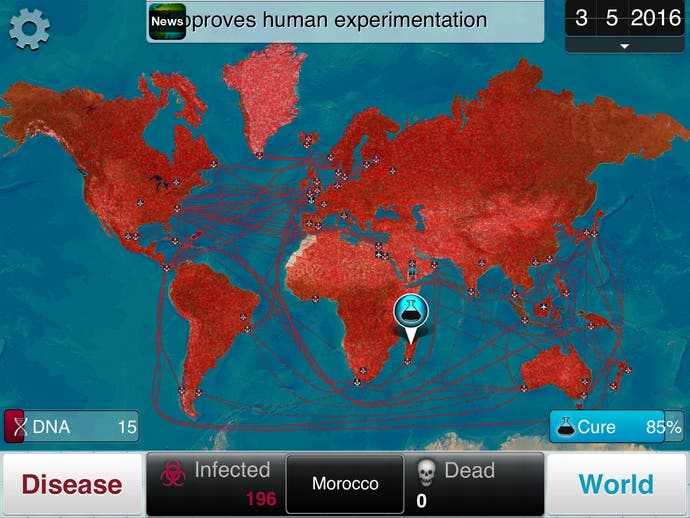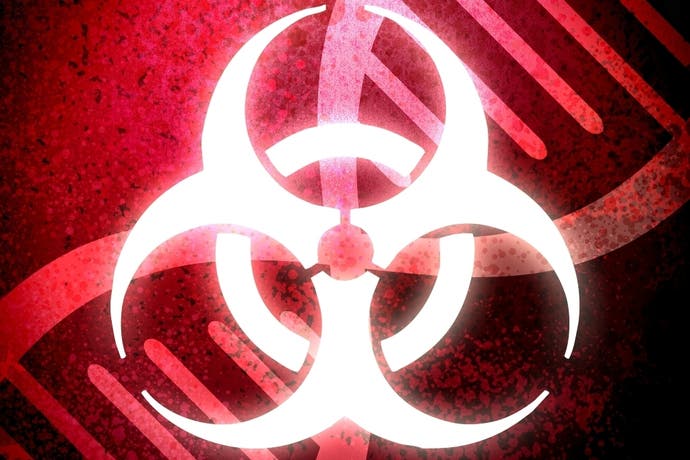Plague Inc. review
Infectious.
The Earth's only real problem, it has often been observed, is humanity. Plague Inc. thus offers the opportunity to save the planet by eradicating our species from existence, giving you control over the evolutions and mutations of various infectious diseases - the means to spread, and then the tools to finish the job. The only obstacles are medical science, hand-washing, and occasionally air filters.
Plague Inc. presents you with a simplified world map and the choice of where your baby infection takes its first steps. How fast it spreads depends on how many ways it can be transmitted and how well you suit it to its current environments, so the early-game upgrade tree concentrates on vectors like insects and birds, or blood transmission, as well as surviving extreme environments. Starting in Afghanistan, for example, a plague that transmits through blood and livestock will spread fast.
Your role at this point is that of observer and nudger-in-chief. Each alteration made to the plague affects where it's spreading and how fast, with poppable icons indicating a new country's infection. Before humanity can be eradicated, which is the really fun part, you've got to make sure you're going to get all of the buggers - anyone left alive means failure.
The plague's spread is represented by red dots in each country and red lines showing infected travel routes, which start sparse and build up to an overwhelming block of colour. Together with the air and sea traffic moving back and forth, much of it now red with infection, this is an oddly hypnotic effect and one made all the more spooky by the random audio clip of a little girl singing "ashes to ashes, we all fall down..." On the plus side, if the next step works, there'll be no little girls left to sing.

In most games of Plague Inc. you'll be wanting to reach 100% worldwide infection before making a move - because as soon as you start to introduce symptoms, even innocuous ones like coughing, people notice they're infected. Symptoms can mutate without any input from you and often have to be devolved (an increasingly expensive pursuit), but are the fun and messy end of Plague Inc. This is where you can make everyone in the world slowly turn insane or simply start pooing their guts out. Comas, paralysis, skin lesions or necrosis, the world is at your mercy - but ready to fight back.
Countries will begin researching a cure, the response dictated by the severity of your disease, and take steps to limit the spread - so when you hit, hit hard. I find going up to total organ failure out of nowhere handles the job nicely. Governments instantly begin throwing maximum resources at the problem, but far too late, and before long several of them have fallen. Every country in anarchy means less money and time devoted to a cure, and it's a delight watching Europe topple piece by piece and cripple worldwide research speed. As the last few million humans begin dying off, living in holes with the cure's progress forever stalled, the game leaves you in silence to watch the Earth's population tick down to zero. Lovely.
Most games of Plague Inc. follow something along these lines, but there's a huge amount of replay value in the different types of plague unlocked through successful games. The starting plague, Bacteria, is versatile and capable of growing a cell wall to circumvent all temperature extremes. The Virus is an unstable plague, regularly mutating new symptoms and hard to control - though this randomness can also make it explode in the right situation. Others include Fungus (slow-moving but capable of infectious 'spore bursts'), Prion (a neural plague that can dampen awareness of symptoms), Parasite (the most delicious, surely, which can be upgraded to full brain control) and Bio-Weapon (automatically gains lethality over time). Perhaps the most unusual and difficult to get right is the Nanomachine - which has escaped from a lab and is being cured and tracked from the game's beginning, but which has unique systems for blocking transmissions and increasing infection rates wildly.

There is even more to Plague Inc., like the perks - gradually unlocked and placed on your chosen pathogen for little boosts - alongside the whole other challenge of Brutal mode. An expansion is also available, which can be bought for £1.49 or unlocked by completing Brutal with all the vanilla virus types, and it introduces a bit of science fiction to the equation: the Neurax Worm.
This is at base a kind of parasite, one capable of dampening humans' reaction to its presence and eventually wreaking havoc on their psychology. Unlike the other virus types it lets you manipulate humans almost directly, evolving to make carriers want to fly to new countries and spread their infection to other humans. What's most fun with the Neurax Worm, however, is enslaving humanity, turning the infected into worshippers, and watching the world struggle to deal with the fallout.
This is part of a minor but important aspect of Plague Inc.'s design. Even with the standard types of plague, there are certain domino effects you can set off. Turning the world slowly paranoid and then insane, for example, might mean that Spalin gets elected in the USA. She knows that the real cause of this virus is those damn Commies, and if you make one more correct move she'll unleash nuclear armageddon. Chalk one up for Team Virus. Other neat surprises include the effects of certain symptom combinations (try sneezing and diarrhoea), and all these little details make Plague Inc.'s world a much richer place than it at first appears.
The only problem with Plague Inc. - and really this is a strength as much as a weakness - is the time it takes to spread the infection. The first few times you play, watching the spread is riveting stuff, but once you've mastered the basics of transmission it's hard not to wish there was an option to play the early part of the game even faster than the 2x speed allowed. It's a choice that undeniably creates tension, but it does mean there's no such thing as a quick game.
That said, killing humanity is such a rare pleasure, we may as well take some time. You can't help but love the mix of reality and macabre humour in Plague Inc., from using the London Olympics to infect Britain to finding a way around Sweden's double whammy of ridiculously good healthcare and a cold climate. It's a game that rewards experimentation as much as focus, raises more than a few laughs, and that's not all. On its Brutal setting, where humanity desperately struggles to survive and often does, Plague Inc. reminds you in its own little way just how fragile yet tenacious humans are. Be a real shame if anything were to happen to them.

